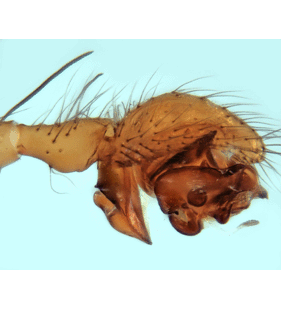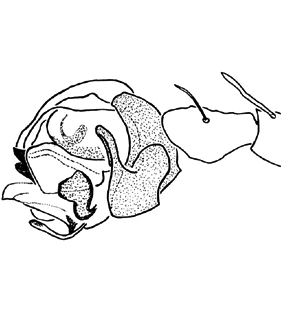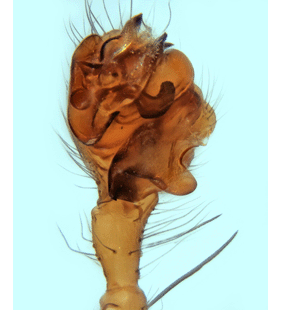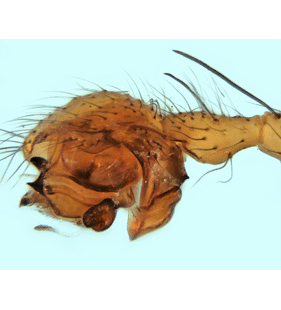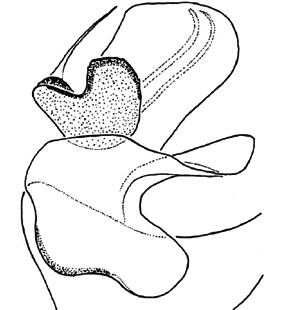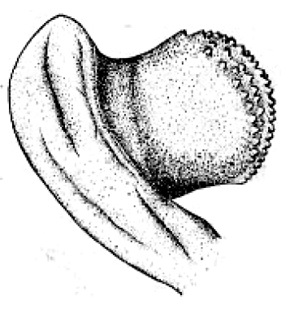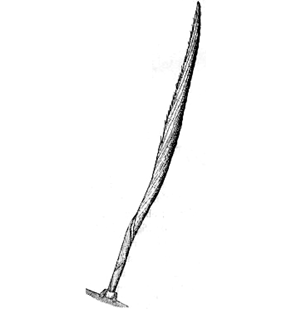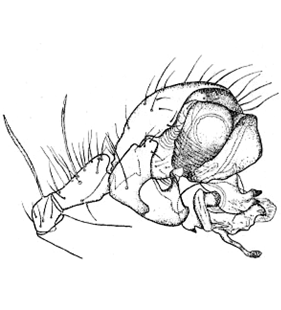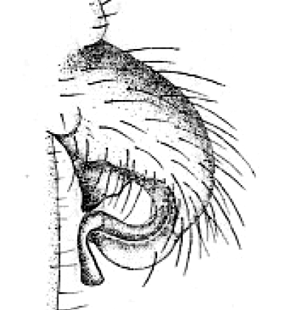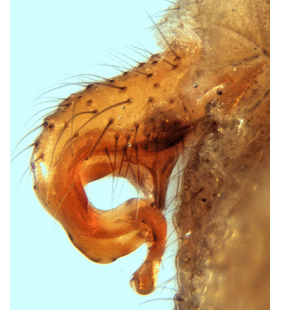Lepthyphantes pieltaini Machado, 1940
Beschreibung
Männchen
Colour: carapace, chelicerae and legs orange-brown, the margin of the prosoma darker; sternum orange-brown; opisthosoma grey to pale grey, darker on the back with 5-6 light transverse lines. Posterior eye line slightly recurved, eyes same size, equally spaced (about one diameter). Chelicerae with three promarginal teeth.
Legs: position of trichobothrium on Mt I 0.131.
Sternum as long as wide.
Pedipalp: patellar spine long and robust, tibia with a lateral spine. Paracymbium wide; proximal part with about ten hairs. Lamella characteristica sclerotized, median part narrow, curved 90° subdistally (visible in ventro-posterior view), apical part flat, short in profile, distinctly widened and provided with fine indentations, two lobes visible in retrolateral view, the dorsal one slightly curved. Terminal apophysis small, flat, rather membranous at base, distal part slightly chitinous, widened and denticulated. Suprategular apophysis very stout and strongly sclerotized, bifid crescent-shaped), the ventral branch with a double indentation (visible in retrolateral view).
Körperlänge Männchen: 2.7-3.2 mmWeibchen
Colour: as in male, but opisthosoma grey to yellowish-grey with 5–6 clear transverse bands in the rear half more or less obvious and contrasted. Eyes: as in male, but PME barely closer together than PLE. Legs: as in male; position of trichobothrium on Mt I 0.121–0.130 (0.125). Sternum: as in male.
Epigyne: relatively simple, triangular in shape, as wide as long. In ventral view, the strongly domed proscape hides almost all the elements of the structure and particularly the median part of scape; posteriorly, only the distal part of the stretcher is visible. Depending on the longitudinal inclination and therefore the view angle, median part of scape may also be partially visible in ventral view.
Körperlänge Weibchen: 2.7-3.9 mmVerbreitung
Phänologie
| Jan | Feb | Mar | Apr | May | Jun | Jul | Aug | Sep | Oct | Nov | Dec |
 |  |
Abbildungen
Verbreitungsnachweise
"No reference" bedeutet nicht, dass die Art in diesem Land nicht vorkommt, sondern dass wir die Referenz hierfür noch nicht eingefügt haben. Wir arbeiten daran.
Literatur
Bosmans R (2006b) Contribution to the knowledge of the Linyphiidae of the Maghreb. Part X. New data on Lepthyphantes Menge (sensu lato) species (Araneae: Linyphiidae). Belgian Journal of Zoology 136: 173-191 ![]()
Lecigne S, Moutaouakil S, Lips J (2023) Contribution to the knowledge of the spider fauna of Morocco (Arachnida: Araneae) – first note – on new records of cave spiders. Arachnologische Mitteilungen 66: 44-71 ![]()
Machado A de B (1940) Una nueva especie cavernicola del género Leptyphantes (Araneae Linyphiidae). International Congress of Entomology Proceedings 6: 515-517 ![]()
WSC (2025) World Spider Catalog. Version 26. Natural History Museum Bern, online at http://wsc.nmbe.ch (28.2.2025) doi: 10.24436/2 ![]()
